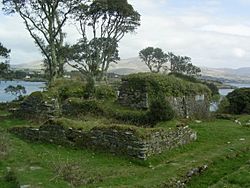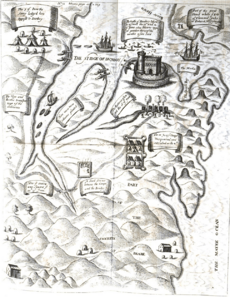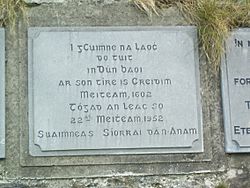Siege of Dunboy facts for kids
Quick facts for kids Siege of Dunboy |
|||||||
|---|---|---|---|---|---|---|---|
| Part of the Nine Years' War | |||||||
 The ruins of Dunboy Castle |
|||||||
|
|||||||
| Belligerents | |||||||
| Commanders and leaders | |||||||
| Sir George Carew | Richard MacGeoghegan | ||||||
| Strength | |||||||
| 4,000–5,000 | 143 in castle, more nearby | ||||||
The Siege of Dunboy was an important battle that happened at Dunboy Castle in Ireland. It took place from June 5 to June 18, 1602. This siege was one of the last big fights during the Nine Years' War. This war was fought between the English army and Irish leaders who wanted to rule themselves.
During the siege, a large English army, led by Sir George Carew, attacked Dunboy Castle. The castle was defended by 143 Irish fighters loyal to Donal Cam O'Sullivan Beare. After 11 days of fighting, the English took the castle. Most of the Irish defenders who were captured were executed. The English also captured another fort on nearby Dursey Island.
Contents
What Was Dunboy Castle?
Dunboy Castle is located near the town of Castletownbere. It sits on the Beara Peninsula in the southwest of Ireland. The castle was a strong stone tower house. Its main job was to protect the important harbour of Bearhaven. This area was a stronghold for Donal Cam O'Sullivan Beare. He was a powerful Irish leader and the 'Chief of Dunboy'.
Why the War Started
O'Sullivan Beare was part of a group of Irish leaders. They decided to fight against the English government that ruled Ireland from Dublin Castle. These Irish leaders got help from King Philip III of Spain. Spain sent soldiers to Ireland, landing at Kinsale.
However, the Spanish commander, Don Juan del Águila, surrendered to the English leader, Lord Mountjoy, in January 1602. Even though the Spanish had given up, O'Sullivan Beare decided to keep fighting. He gathered his forces at Dunboy Castle.
Preparing for Battle
Before the English arrived, O'Sullivan Beare had to get his castle back. A small group of Spanish soldiers were holding it. They were getting ready to hand the castle over to the English as part of the surrender deal. But O'Sullivan's men quickly took control of the castle from them. They let the Spanish soldiers go back to Spain.
O'Sullivan Beare kept all the weapons and supplies the Spanish left behind. He quickly made the castle stronger. He knew the English would attack soon. He left 143 of his best fighters to defend the castle. Their leader was Captain Richard MacGeoghegan. Friar Dominic Collins was also there to help.
The English sent a very large army, between 4,000 and 5,000 soldiers. They were led by Sir George Carew. He was the English Lord President of Munster. Carew also had the support of the English navy. But before the siege began, O'Sullivan Beare and most of his main army had already left. They went to another castle, Ardea Castle. They needed to get money and supplies that had just arrived from Spain.
The Siege Begins
Sir George Carew started the attack with a heavy bombardment. Cannons fired from both land and sea. One of O'Sullivan's own cousins, Owen O'Sullivan, had joined the English side. He told Carew about a weak spot in the castle walls, near a stairwell.
The English cannons then focused their fire on this weak point. Eventually, they broke through the castle walls. By the tenth day of the siege, the castle was mostly in ruins.
A Desperate Fight
Richard MacGeoghegan, the Irish commander, saw that the situation was hopeless. His son, Bryan, had been killed. He sent a messenger to Carew to ask for terms of surrender. However, in wars of that time, if a battle had already started, the defenders usually had to surrender completely without any conditions. Carew refused MacGeoghegan's request and made an example of the messenger.
Knowing what would happen if they stayed, some of the Irish defenders tried to escape. They swam to nearby Bere Island. But they were either killed or captured in the water. The remaining defenders fought off another English attack. They then barricaded themselves in the castle's cellar.
On the eleventh day, the English finally broke into the cellar. There was fierce hand-to-hand fighting. MacGeoghegan was badly wounded as he tried to light the gunpowder stores. He wanted to blow up the cellar and himself rather than surrender.
Almost all of the Irish defenders captured during this final assault were executed. They were taken to the market square in nearby Castletown Berehaven. Two other captives were executed because they refused to give information to the English. Friar Dominic Collins was questioned by Carew. Collins refused to swear loyalty to the English Crown. He was then taken to his hometown of Youghal and executed there.
The Dursey Island Incident
While the siege of Dunboy was happening, an English group also attacked a fort on nearby Dursey Island. This fort was also held by O'Sullivan's forces. According to Irish accounts, all 300 people in the fort were killed. This included women and children who were hiding there. This event became known as the Dursey Island massacre.
What Happened Next
After Dunboy Castle fell, O'Sullivan Beare continued to fight the English. He used guerrilla warfare tactics, which means small groups fighting quick, surprise attacks. He managed to capture at least six more castles.
But O'Sullivan Beare and his people faced huge challenges. They were outnumbered and starving. So, he decided to lead a long, difficult march to join his allies in the north of Ireland. This journey is known as "O'Sullivan's March". He started with about 1,000 people, including men, women, and children.
O'Sullivan's group had many conflicts during their long journey. When they finally reached the safety of O'Rourke's castle in West Breifne, only 35 people were left. Many had died in battles or from hunger and cold. Others had settled along the way. Their descendants are still known as 'the Beres' today.
In West Breifne, O'Sullivan wanted to team up with other northern Irish chiefs to keep fighting the English. But the main Irish leader, Hugh O'Neill, Earl of Tyrone, decided to make peace with the English. He swore loyalty to the English Crown. O'Sullivan Beare did not want to do this. He chose to leave Ireland and went to Spain. He was later murdered there.



